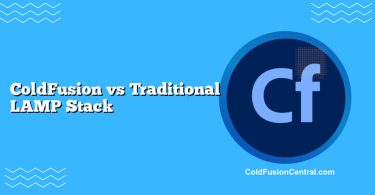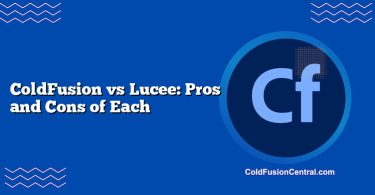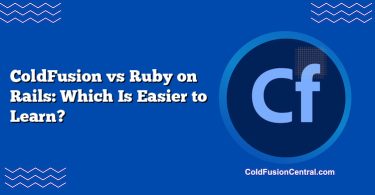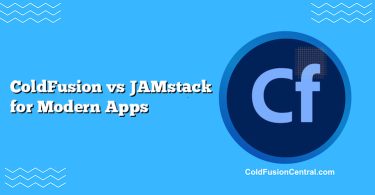Definitions
-
ColdFusion: A rapid application development platform built around the CFML language, historically from Allaire/Macromedia and now Adobe (with a popular open-source engine called Lucee). ColdFusion applications run on the JVM, use tag-based and script-style syntax (CFScript), and include a rich set of built-in services (PDF generation, email, schedulers, caching, ORM via Hibernate, and more).
-
Flask Microframework: A lightweight Python web framework following a “micro” philosophy—providing the essentials (routing, request/response handling, Jinja2 templating) while letting you add extensions for databases, security, forms, and API tooling. It’s commonly deployed with WSGI servers such as Gunicorn or uWSGI and fits well in microservices and API-driven architectures.
Overview
Choosing between ColdFusion (Adobe CF or Lucee) and Flask (Python) depends on priorities such as development speed, licensing cost, ecosystem reach, and operational model. ColdFusion is opinionated and batteries-included, offering many enterprise-friendly features out of the box with a CFML runtime on the JVM. Flask is minimalist, modular, and flexible, thriving in ecosystems where Python skills, data tooling, and cloud-native practices are abundant.
Think of ColdFusion as a “platform” and Flask as a “framework.” ColdFusion brings pre-integrated services; Flask is a small core with a large universe of extensions, libraries, and third-party tooling.
Architecture and Philosophy
ColdFusion (Adobe CF / Lucee)
- Runs atop the JVM (usually on Tomcat), compiles CFML templates to Java bytecode.
- Emphasizes rapid application development with tag-based components (e.g., cfquery, cfmail) and CFScript for more traditional coding structure.
- Built-in services (PDF, Office integration, scheduling, caching, ORM) reduce reliance on external services for common enterprise tasks.
Flask (Python)
- A WSGI microframework with a minimal core, relying on extensions for database access, authentication, session storage, input validation, and rate limiting.
- Emphasizes explicit decisions and composability. You pick your ORM (e.g., SQLAlchemy), form handling, security middlewares, and deployment stack.
- Integrates seamlessly with Python’s data and scientific stack (Pandas, NumPy, scikit-learn), making it a natural fit for ML-infused APIs.
Key Features
ColdFusion Highlights
- Built-in PDF generation, charting, cfmail for email, cfhttp for HTTP calls, and scheduled tasks.
- ORM support (Hibernate) and CFQueryParam for secure SQL parameterization.
- Enterprise features: server monitoring, clustering support (Adobe CF Enterprise), task scheduler.
- Security helpers: EncodeForHTML, EncodeForJavaScript; sandboxing; centralized datasources.
- Strong JVM performance tuning possibilities and integration with Java libraries.
Flask Highlights
- Minimal core: routing, request/response, Jinja2 templating.
- Rich extension ecosystem: Flask-SQLAlchemy, Flask-Login, Flask-WTF, Flask-Limiter, Flask-RESTX, marshmallow, and more.
- Python-native: easy use of data science libraries and async patterns (Flask supports async routes but remains WSGI; for full ASGI consider Quart/FastAPI).
- Cloud-native friendly: excellent with Docker, Kubernetes, CI/CD, observability tools, and serverless adapters.
Performance
-
ColdFusion:
- The JVM can deliver strong performance once warmed up and tuned (JIT optimizations, heap sizing, GC tuning).
- CFML tags and dynamic features add convenience but introduce overhead; caching (template, query, object) and ORM tuning matter.
- Good at heavy server-side processing tasks when properly configured; startup time can be longer due to JVM.
-
Flask:
- Generally fast for lightweight APIs; performance depends on the WSGI server (Gunicorn/uWSGI), worker model, and code efficiency.
- For maximum Python web performance, ASGI frameworks (e.g., FastAPI, Quart) are often chosen; Flask can still be highly competitive for REST APIs with proper caching and IO-bound optimizations.
- Python’s single-threaded nature per worker encourages horizontal scaling and async patterns where appropriate.
Practical takeaway: For raw, high-throughput microservices, a tuned Flask stack with a proper WSGI server and caching often performs very well. ColdFusion can match or exceed for certain server-side workloads with JVM tuning and built-in services, but its convenience abstractions can cost cycles.
Scalability
-
ColdFusion:
- Scales vertically via JVM tuning and horizontally at the web/app tier with load balancers (HAProxy, Nginx, F5).
- Adobe CF Enterprise offers features that help with clustering; Lucee on Tomcat can be clustered similarly.
- Use session replication, sticky sessions, or external session stores; leverage Redis/Memcached for distributed caching.
-
Flask:
- Designed for horizontal scaling: containerize with Docker, run multiple Gunicorn workers/pods behind Nginx or an ingress, orchestrate with Kubernetes.
- Externalize state (sessions in Redis, SQL/NoSQL DBs), centralize config via env vars and secrets, scale out replicas easily.
- Plays nicely with managed services and serverless platforms (e.g., deploying to Cloud Run, AWS Elastic Beanstalk, or even serverless via Zappa-style tooling).
Security
-
ColdFusion:
- Built-in cfqueryparam encourages parameterized SQL; encoding functions mitigate XSS.
- Sandbox security, role-based authentication helpers, and enterprise patching from Adobe; Lucee maintains its own update cadence.
- Vulnerabilities typically relate to misconfiguration or outdated servers; keep up with CVE advisories and patch cycles.
-
Flask:
- Security is extension-driven: CSRF via Flask-WTF, auth via Flask-Login/JWT libraries, rate limiting via Flask-Limiter, input validation with marshmallow/Pydantic.
- OWASP best practices are easy to adopt; abundance of guides and security tools in the Python ecosystem.
- You must curate dependencies and maintain updates aggressively.
Bottom line: ColdFusion offers strong built-in security helpers; Flask offers robust security through best-of-breed extensions and disciplined DevSecOps.
Cost and Licensing
-
ColdFusion:
- Adobe ColdFusion is commercial with per-core licensing; the Enterprise edition is higher cost but includes advanced features. Budget for support contracts.
- Lucee is open-source and free to use, appealing for cost-sensitive or open-source-first organizations.
-
Flask:
- Entirely open-source; costs center on infrastructure, developer time, and support you might contract from vendors or consultants.
- Python talent is widespread, reducing hiring and training costs in many markets.
Ecosystem and Community Support
-
ColdFusion:
- A smaller but dedicated community with long-lived enterprise deployments (government, finance, higher education).
- Fewer third-party libraries than Python, but strong tooling and commercial support from Adobe; the Lucee community is vibrant for open-source users.
-
Flask:
- Massive Python ecosystem: databases, async tooling, observability, ML/AI, testing frameworks, cloud SDKs, and DevOps tooling.
- Extensive community support, tutorials, and Stack Overflow coverage.
Supported Platforms and Deployment Targets
-
ColdFusion:
- Servers: Windows and Linux are primary targets; Mac commonly used for development.
- App servers: Built on Tomcat; integrates with web servers (IIS/Apache/Nginx).
- Java interoperability lets you leverage the JVM ecosystem.
-
Flask:
- Runs wherever Python runs: Linux, macOS, Windows.
- Deployment: Gunicorn/uWSGI + Nginx, Docker containers, Kubernetes, PaaS (Heroku-like), serverless (Cloud Run, AWS Lambda with adapters).
- Rich monitoring with Prometheus, OpenTelemetry, and cloud-native log/trace services.
Step-by-Step: Building a Simple REST API
ColdFusion (CFML)
- Define a datasource in the administrator (centralized DB config).
- Create a CFC (ColdFusion Component) exposing methods (REST mappings if using REST services).
- Use cfquery with cfqueryparam for CRUD operations.
- Return JSON via serializeJSON().
- Deploy to Adobe CF or Lucee; configure URL mappings in the server admin.
What you get: very quick to wire DB + JSON + scheduling + email without extra libraries.
Flask (Python)
- Create a virtual environment; pip install Flask, SQLAlchemy, Flask-Migrate.
- Define models (SQLAlchemy), migrations (Alembic/Flask-Migrate), and routes returning JSON.
- Add Flask-HTTPAuth/JWT for auth, Flask-Limiter for rate limits, and Marshmallow for serialization.
- Run with Gunicorn behind Nginx; containerize for dev/prod parity.
What you get: granular control and modularity with access to the full Python ecosystem.
Real-World Use Cases
-
When ColdFusion shines:
- An enterprise needs to modernize an existing CFML intranet with PDFs, scheduled reports, and email workflows.
- A small team wants to ship a complex back-office app quickly using built-in services without assembling many third-party components.
- Integration with Java libraries on the JVM is desirable.
-
When Flask shines:
- You’re building microservices and REST APIs deployed on Kubernetes, leveraging Python data libraries and ML models.
- The organization values open-source, avoids license fees, and prefers cloud-native toolchains.
- Teams want maximum flexibility and broad hiring pools for Python developers.
Side-by-Side Comparison Table
| Aspect | ColdFusion (Adobe CF / Lucee) | Flask (Python) | Notes |
|---|---|---|---|
| Paradigm | Full-stack platform on the JVM | Minimal WSGI microframework | CF provides many built-ins; Flask relies on extensions |
| Performance | Strong with JVM tuning; convenience features add overhead | Fast for lightweight APIs; scale via workers; ASGI alternatives may be faster | Both benefit from caching, profiling, and proper deployment |
| Scalability | Vertical + horizontal; clustering options; session replication | Horizontal-first; containers, Kubernetes, serverless-friendly | Externalize state for both |
| Security | Built-in helpers (cfqueryparam, encoding, sandbox) | Extension-based security (CSRF, JWT, rate limiting) | Either can be secure with good practices |
| Cost | Adobe CF is commercial; Lucee is free | Open-source; infra + ops cost only | Python talent often reduces long-term costs |
| Ecosystem | Smaller but enterprise-focused; JVM interop | Vast Python ecosystem (data, ML, DevOps) | Community size favors Flask |
| Learning Curve | Quick RAD; CFML syntax approachable | Straightforward if you know Python; more decisions to make | Flask encourages reading docs on extensions |
| Best For | Legacy CFML apps, rapid back-office builds, JVM-first shops | Microservices, ML-backed APIs, cloud-native stacks | Choose based on team skillset and requirements |
| Pros | Built-in services, fast RAD, enterprise features | Flexibility, massive ecosystem, cloud-native deployment | |
| Cons | Licensing (Adobe), smaller community, JVM cold start | More assembly required, dependency management |
Pros and Cons
ColdFusion Pros
- Rapid application development with built-in PDF, mail, scheduling, and ORM.
- Runs on the JVM with access to Java libs and mature profiling/tuning tools.
- Centralized administration (datasources, caches) and enterprise features.
- Lucee offers an open-source path with good performance.
ColdFusion Cons
- Adobe licensing cost (if not using Lucee) and potential vendor lock-in.
- Smaller community and fewer modern cloud-native tutorials.
- Longer start-up times; convenience features can impact raw performance if not tuned.
Flask Pros
- Lightweight and flexible; pick the best-in-class libraries you need.
- Huge Python ecosystem (data science, ML, testing, DevOps).
- Excellent cloud-native story: Docker, Kubernetes, serverless.
- Strong community support and abundant learning resources.
Flask Cons
- Requires assembly of extensions, configuration, and maintenance.
- Security and performance are your responsibility to curate and enforce.
- For advanced async or extreme throughput, you might consider ASGI frameworks instead.
Decision Factors / Which One Should You Choose?
-
Choose ColdFusion if:
- You inherit or maintain substantial CFML codebases.
- You value built-in enterprise features over assembling third-party components.
- You operate in a JVM-centric environment and want Java interoperability.
- You prefer a RAD platform with administrative tooling to configure datasources, caches, and schedulers.
-
Choose Flask if:
- Your team lives in Python, needs ML/data integration, or wants the broadest developer pool.
- You’re building APIs/microservices and deploying with Docker/Kubernetes or serverless.
- You want open-source flexibility and minimal licensing cost.
- You expect to leverage the Python ecosystem for observability, testing, and CI/CD.
Rule of thumb: If you’re standing up a new, cloud-native API or microservice and have Python expertise, pick Flask. If you’re iterating on an existing CFML platform or need a cohesive feature-rich server platform and can accept licensing (or opt for Lucee), ColdFusion is pragmatic.
Key Takeaways / Summary Points
- ColdFusion is a full-featured platform on the JVM with built-in services that accelerate enterprise app development; Flask is a minimal Python framework that thrives in modular, cloud-native environments.
- Performance depends more on architecture and tuning than labels—both can be fast with proper caching, DB optimization, and deployment.
- Cost and ecosystem gravity are decisive: Adobe ColdFusion licenses vs. Flask’s open-source model and massive Python community.
- For legacy modernization and rapid server-side features, ColdFusion (or Lucee) is compelling. For microservices, ML-driven APIs, and cloud ops, Flask is the safer long-term bet.
- Your team’s skills and your organization’s tooling should drive the final choice.
FAQ
Is ColdFusion still used, and is it relevant in 2025?
Yes. Many enterprises, governments, and universities still run mission-critical CFML applications. Adobe continues to release new versions, and Lucee offers an active open-source path. Relevance depends on your context: for existing CFML estates, it’s highly relevant; for greenfield, weigh it against modern open-source stacks.
Can Flask handle enterprise-scale workloads?
Absolutely. With Gunicorn/uWSGI, proper worker tuning, Redis caching, a robust database, and Kubernetes or auto-scaling infrastructure, Flask powers high-traffic APIs. Security and reliability rely on disciplined engineering and well-chosen extensions.
How does Lucee compare to Adobe ColdFusion?
Lucee is a fast, open-source CFML engine running on the JVM. It lacks some Adobe enterprise features and commercial support bundles, but it’s widely adopted for cost-sensitive deployments and offers strong community support. Many CFML apps run well on Lucee with minor adjustments.
What about async and real-time features?
Flask supports async route handlers, but it’s still fundamentally WSGI. For heavy async or real-time websockets, consider Quart (Flask-like API on ASGI), FastAPI, or socket servers like Uvicorn/Hypercorn. In ColdFusion, real-time is typically achieved via integration (e.g., WebSocket servers, message queues) rather than native async-first patterns.
How easy is it to hire developers for each stack?
The Python talent pool is generally larger, especially with data and cloud skills, making Flask teams easier to staff. ColdFusion developers are fewer but experienced; if you already rely on CFML, retaining that expertise can be valuable.




